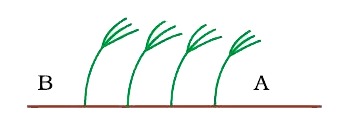Which method would you suggest for the separation of the metals in the following mixtures ?
(a) Zinc and iron
(b) Copper and magnesium
(c ) Rare earths
Give reasons for your choice.
Zinc and iron : Zinc and iron can be separated from the mixture by fractional distillation. The mixture is distilled, when zinc with low boiling point distils over leaving behind iron.
(ii) Copper and magnesium : Copper and magenesium metals can be separated from the mixture by electrolytic refining. The mixture metal is converted into a rod and made the anode, while a thin thin plate of Pure copper serves as the cathode. The electrolytic tank contains a solution of copper sulphate acidified with dil. H2SO4, which acts as the electrolyte on passing electricity. Cu2+ and thus these Cu2+ ions are discharged at the cathode as pure metal.
(iii) Rare earths : Rare earths includes lanthanides and actinides. All lanthanide ions are typically trivalent M3+ and almost identical in size. Their chemical properties. which are determined by the size and charge of their ions, are almost identical. This renders the separation of one metal from another difficult . Different methods employed for their separation given below are based on the light diffenerces in their solubility, stability, and basic properties. Modern methods are based on valence change and ion exchange.
(1) Ion exchange method
(This is a very effective and rapid method)
(2) Complex formation
(3) Solvent extraction
(4) Fractional crystallisation
Valency change method
(5) Thermal reaction
(6) Precipitation.
Topper's Solved these Questions
- GENERAL PRINCIPLES AND PROCESS OF ISOLATION OF ELEMENTSBOOK - CENGAGE CHEMISTRYCHAPTER - GENERAL PRINCIPLES AND PROCESS OF ISOLATION OF ELEMENTSEXERCISE - Exs 1.1 (Objective)
14 Videos
- GENERAL PRINCIPLES AND PROCESS OF ISOLATION OF ELEMENTSBOOK - CENGAGE CHEMISTRYCHAPTER - GENERAL PRINCIPLES AND PROCESS OF ISOLATION OF ELEMENTSEXERCISE - Exs 1.1 (True Orfalse Statement)
19 Videos
- GENERAL PRINCIPLES AND PROCESS OF ISOLATION OF ELEMENTSBOOK - CENGAGE CHEMISTRYCHAPTER - GENERAL PRINCIPLES AND PROCESS OF ISOLATION OF ELEMENTSEXERCISE - Solved Example
25 Videos
- ELECTROCHEMISTRYBOOK - CENGAGE CHEMISTRYCHAPTER - ELECTROCHEMISTRYEXERCISE - Archieves Subjective
35 Videos
- GRIGNARD REAGENTS AND ORGANOMETALLIC REAGENTSBOOK - CENGAGE CHEMISTRYCHAPTER - GRIGNARD REAGENTS AND ORGANOMETALLIC REAGENTSEXERCISE - Exercises Archives (Linked Comprehension)
1 Video
Similar Questions
Knowledge Check
Which of the following is not observed in a homologous series? Give reason for your choice.
AChange in chemical propertiesBDifference in−CH2 and 14u molecular massCGradation in physical propertiesDSame functional group
Suggest methods for the separation of the following mixtures :
A mixture of liquid A (b.p.365 K) and liquid B (b.p. 356 K).
View SolutionName two energy sources that you would consider to be renewable. Give reasons for your choices.
View SolutionName two energy sources that you would consider to be renewable. Give reasons for your choices.
View SolutionName two energy sources that you would consider to be renewable. Give reasons for your choices.
View SolutionFigure shows a diagrammatic representation of trees in the afternoon along a sea coast. State on which side is the sea, A or B? Give reasons for your choice.

View SolutionWhich of the following mixtures would you be able to separate using the method of filtration?
View SolutionName two energy sources that you would consider to be renewable. Give reasons for your choices.
View Solution